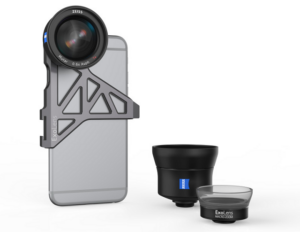Would anyone debate that the compact camera market is being taken over by smartphones? Industry players whom I’ve spoken to certainly don’t: the digital camera market is increasingly veering towards premium models, as the demand is simply not there at the low-end.

In the past few years, several companies have worked on ways to improve the image quality of pictures taken with smartphone cameras. Sony has a range of lenses, including some with very impressive levels of optical zoom (Sony Mobile Focuses on Imaging – subscription needed), and DxO has a premium lens built specifically for the iPhone (DxO Boasts of World’s First ‘Truly Connected Camera’ – subscription needed).
Many companies are part of this add-on lens market, although unlike Sony and DxO, most produce low-cost units in the $5-$10 range. It is doubtful whether these aid photography at all! That is why it was exciting to see an announcement at CES 2016 by Carl Zeiss, maker of professional camera lenses (for an exhaustive list of Zeiss lenses, see Wikipedia). The company is working with Fellowes Brands to produce its own add-on iPhone lenses.
Known as the Fellowes’ ExoLenses, the range will begin with three products: wide-angle (0.6x), telephoto (2x) and macro. Each will feature Zeiss technologies – such as the T* anti-reflective coating – and design: black aluminium with white lettering. They are attached to iPhone 6 models using a specific mount.
 Image: Topher DeLancyThe wide-angle and telephoto lenses use an afocal system, with no focal length (the focus is set at infinity). The limits of thee focus, therefore, are defined by the phone, and makes the lenses suitable for both landscape and close-up photography. The effect of distortion (off-centre straight lines reproduced as curved lines) has been offset through the use of aspheric lenses.
Image: Topher DeLancyThe wide-angle and telephoto lenses use an afocal system, with no focal length (the focus is set at infinity). The limits of thee focus, therefore, are defined by the phone, and makes the lenses suitable for both landscape and close-up photography. The effect of distortion (off-centre straight lines reproduced as curved lines) has been offset through the use of aspheric lenses.
Zeiss’ macro lens complements the other units. As with all Zeiss lenses, distortion and chromatic aberration (in the transition between light and dark areas) are compensated for. It also features a continuous zoom function, and can be used for full-frame capture of objects between 3cm and 12cm. An optional diffuser, which also acts as a spacer, can be attached.
It is interesting to see a an established maker of professional camera components – Zeiss has been operating since 1890 – making inroads into the add-on lens market. It could be argued that camera makers are being forced to branch out, with the state of the market today, but Zeiss has already done so: its optics are featured in the cameras of Sony’s smartphones. This deal further diversifies the company’s portfolio.
Zeiss and Fellowes will begin to sell the new ExoLenses in Q2’16. The wide-angle and macro lenses will be sold together, with a mount and carrying case, for $300; the telephoto lens will be available separately, for $200.
All of that said, a major concern for smartphone photography is battery life, and the Zeiss lenses do nothing to help with that. The only option for phone photographers remains to carry a spare battery or charging pack. Until this issue is solved, I will hold my doubts about a phone becoming a true camera replacement.
– Tom Allen

